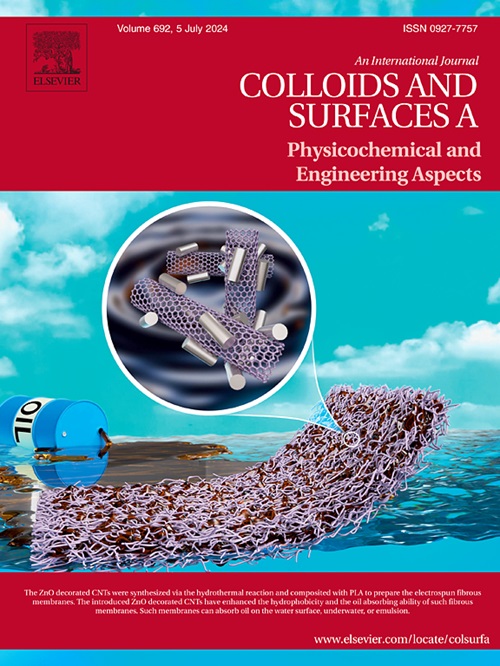Hierarchical CuO@Ni/NiO nanoarchitectures with dual synergistic effects for industrial high-current-density hydrogen evolution
IF 5.4
2区 化学
Q2 CHEMISTRY, PHYSICAL
Colloids and Surfaces A: Physicochemical and Engineering Aspects
Pub Date : 2025-07-16
DOI:10.1016/j.colsurfa.2025.137744
引用次数: 0
Abstract
The development of efficient and durable non-precious metal catalysts for hydrogen evolution reaction (HER) remains a significant challenge. In this work, we present a novel approach combining heterojunction and structural engineering to enhance HER performance. A NiO/Ni layer with a heterogeneous structure is grown on CuO nanorod arrays supported by copper foam. This 3D nanostructure increases the density of active sites, improves mass and electron transport, and accelerates HER kinetics. The rough surface also facilitates rapid bubble release, enhancing catalyst stability under high currents. As a result, the CuO@NiO/Ni catalyst exhibits excellent HER performance, with overpotentials of 86.5 and 198.8 mV at 100 and 500 mA cm−2, respectively. Additionally, a two-electrode electrolytic cell using CuO@NiO/Ni and NiFe LDH achieves 500 mA cm−2 at only 1.64 V and maintains excellent stability over 100 h. These findings highlight the potential of CuO@NiO/Ni as a highly efficient, stable catalyst for industrial-scale water electrolysis, and provide a promising approach to addressing the challenges of non-precious metal-based HER catalysts in industrial settings.
具有双重协同效应的工业高电流密度析氢层叠CuO@Ni/NiO纳米结构
开发高效、耐用的非贵金属析氢催化剂仍然是一个重大挑战。在这项工作中,我们提出了一种结合异质结和结构工程的新方法来提高HER性能。在泡沫铜支撑的CuO纳米棒阵列上生长出具有非均相结构的NiO/Ni层。这种3D纳米结构增加了活性位点的密度,改善了质量和电子传递,加速了HER动力学。粗糙的表面也有助于快速释放气泡,增强催化剂在大电流下的稳定性。结果表明,CuO@NiO/Ni催化剂在100和500 mA cm−2下的过电位分别为86.5和198.8 mV,具有优异的HER性能。此外,使用CuO@NiO/Ni和NiFe LDH的双电极电解电池在1.64 V下达到500 mA cm−2,并且在100 h以上保持出色的稳定性。这些发现突出了CuO@NiO/Ni作为一种高效、稳定的工业规模水电解催化剂的潜力,并为解决工业环境中非贵金属基HER催化剂的挑战提供了一种有希望的方法。
本文章由计算机程序翻译,如有差异,请以英文原文为准。
求助全文
约1分钟内获得全文
求助全文
来源期刊
CiteScore
8.70
自引率
9.60%
发文量
2421
审稿时长
56 days
期刊介绍:
Colloids and Surfaces A: Physicochemical and Engineering Aspects is an international journal devoted to the science underlying applications of colloids and interfacial phenomena.
The journal aims at publishing high quality research papers featuring new materials or new insights into the role of colloid and interface science in (for example) food, energy, minerals processing, pharmaceuticals or the environment.

 求助内容:
求助内容: 应助结果提醒方式:
应助结果提醒方式:


